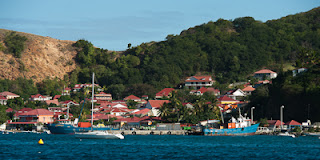Anse Fideling proved rolly as well so both James and I
were already awake to move at first light. We ran at 8kts across to Vieux Fort
then rapidly lost the wind in the lee of Basse-Terre. We had an erratic sail –
motor – sail but made Pigeon Island by 11am. This is one of the first marine
reserves, on the insistence of the legendary Jacque Cousteau who said it was
one of the best dive sites in the world.
 |
| Dismasted yacht at anchor - presumably off to Antigua for repairs. |
Beneath the waves, the island site was one of the best
shallow coral gardens I have ever dived. The coral was healthy and thick, and
even the near sand bed was a thriving animal community. The fish were abundant,
from juveniles to large grunts and snappers. Off the anchorage, the bed was sea
grass on sand and home to good numbers of large hawksbill turtles. One stopped
grazing and lifted off towards me when I saw it had just dislodged a
hitch-hiking large remora, longer than the large turtle. I swam away rapidly
for fear the remora would prefer me.
 |
| Pigeon Island marine reserve |
Guadeloupe itself is also superficially European, with
obvious large urban areas of late 20th century housing. Anchorages
on the west coast are sparse and ashore prices are less “bonne-marche”. We
arrived in Deshaies late afternoon to a plague of yachts but managed a good
spot near the beach. After a drink ashore we made the most of our last
opportunity to buy French cheeses and retired aboard for our last night in
Europe for a while.
 |
| Guadeloupe's west coast |















